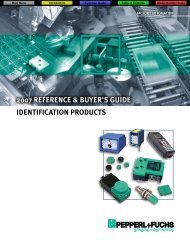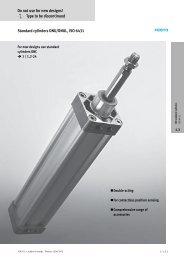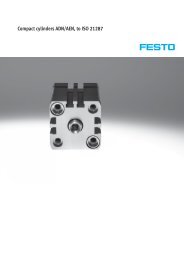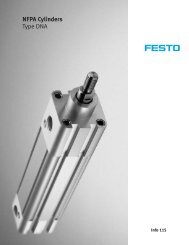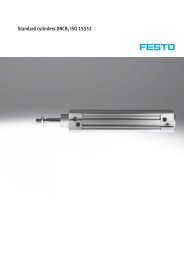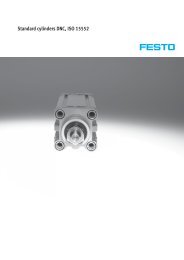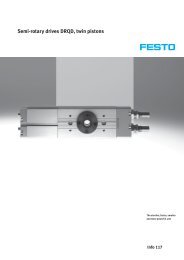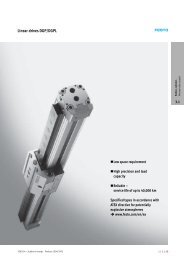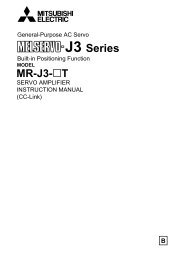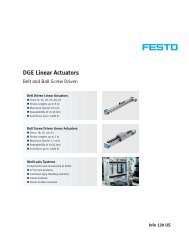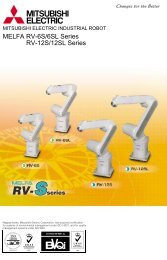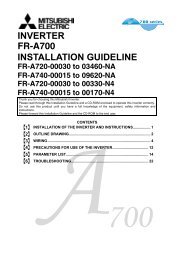Catalog â Components - Allied Automation, Inc.
Catalog â Components - Allied Automation, Inc.
Catalog â Components - Allied Automation, Inc.
Create successful ePaper yourself
Turn your PDF publications into a flip-book with our unique Google optimized e-Paper software.
Design ConsiderationsSafety FactorsAs a practice, safety factors should always be used whenselecting a linear bearing or carriage assembly for a givenapplication. For most real world applications people do usesafety factors. However, sometimes the incorrect safetyfactor or no safety has been used. This can lead into anunexpected system failure. LINTECH provides, in a chartform, different safety factor recommendations for linearbearings or carriage assemblies. Keep in mind that theserecommendations for safety factors are not hard and fastrules. Safety factors for a specific linear bearing may haveto be increased or decreased based upon the applicationrequirements.Linear Bearing Load CapacitiesLinear Bearing Load Capacities are specified with a dynamicvalue. These values are used to help select the properlinear bearing or carriage assembly size for a given load/lifeapplication. The use of adequate safety factors is a keyelement in the selection process of a linear bearing systemfor a given application. Selecting a bearing with no safetymargin can lead to problems relating to performance andlong term life.Dynamic Loads exert a force upon the linear bearings orcarriage assembly while in motion. Every linear bearing orcarriage assembly has a load capacity associated with it thatis based upon the number of inches (or km) traveled. If theload applied to the carriage is less than the rated value at 2million inches (or 50 km) of travel, the linear bearings willhave a longer life associated with them that is exponential.Therefore, to properly select a linear bearing or carriageassembly that will last the required travel life for an application,the forces acting upon the linear bearings need to bereviewed. Once the force on the heaviest loaded bearing hasbeen determined and a proper safety factor selected, thenthe life of that bearing or carriage assembly can be determinedby using a simple mathematical equation.Even though the forces acting upon a bearing or carriage assemblycan be calculated, other parameters such as changingloads, speeds, acceleration rates, environments, and lack oflubrication produce extra forces (stresses) that are hard toquantify. As a bearing moves, there are additional resultantloads as a by-product. The rate at which the bearing beginsto move a load can have a large impact on its life. Thelinear bearings see this start/stop rate as a shock load eachtime. These and other variable loads cannot be calculatedprecisely. Thus, a safety factor should be applied to accountfor these loads which could fatigue the system and causepremature failure. See the below chart as a guideline.Impacts orVibrationNoneSmallMediumLargeRecommended Linear Bearing Dynamic Safety FactorsVery LargeSpeed(in/sec)Min. SafetyFactor - S< 5 < 0.25 1.0 - 2.05 - 1010 - 20Safety Factor ExampleAcceleration(G's)0.25 - 0.5020 - 50 1.00 - 1.50Load Capacities2.0 - 3.00.50 - 1.00 3.0 - 4.04.0 - 6.0> 50 > 1.50 6.0 - 8.0Application calls for an external 1,500 lbs of force to beapplied to a part (weight = 100 lbs) that is mounted to acarriage assembly. The system will be at rest. There willbe a small impact to the part (and carriage assembly) asthe force is first being applied.totalloadFrom chart 1 - use a 3.5 factorfactorselect a carriage assembly thathas a static capacity greaterthan this value(1,500 + 100) x 3.5 = 5,600 lbsA-8LINTECH ®Positioning <strong>Components</strong>



